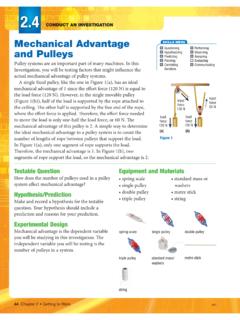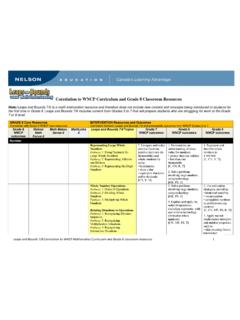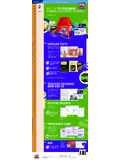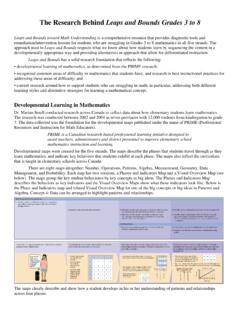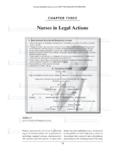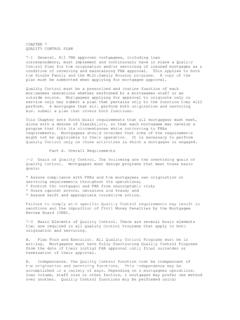Transcription of Student Book Sample Pages - Nelson
1 Student book Sample Pages Unit A: Systems in Action Draft Material for Review Only. SYSTEMS IN ACTIONUNIT AUTHORC huck HammillPeel District School BoardGRADE 8 AUTHOR TEAMD ennis Par Ottawa-Carleton District School BoardDouglas HayhoeTyndale University CollegeChuck HammillPeel District School BoardTed GibbUniversity of Western Ontario Maurice DiGiuseppe, Toronto Catholic District School BoardSENIOR PROGRAM CONSULTANTM aurice DiGiuseppe, Toronto Catholic District School BoardPROGRAM CONSULTANTJ effrey Major Thames Valley District School i7/23/08 11:21:58 AM7/23/08 11:21:58 AMiv Table of ContentsNELT able of ContentsUnit Preview .. 2 Downhill Daredevils .. 4 Let s Get Started: Components of a Bicycle Race .. 6 Unit Task Preview: Helping Hands .. 7 chapter 1 INTRODUCING SYSTEMS .. 8 Reading Science and Technology: More Th an Meets the Eye .. Types of Systems .. Systems Components .. 13 Tech Connect: Aliens, Elephants, and Grinning Gorillas Th e World of Animatronics.
2 PERFORM AN ACTIVITY: Examining Physical Systems .. Systems Evolve .. 20 Try This: A School Litter Management System .. EXPLORE AN ISSUE CRITICALLY: Consumerism .. 22 chapter 1 Summary .. 24 chapter 1 Review .. iv7/23/08 11:22:10 AM7/23/08 11:22:10 AM Table of Contents vNELC hapter 2 GETTING TO WORK .. 28 Reading Science and Technology: All in a Morning s Work .. Physical Systems: Simple Machines .. A Closer Look at Forces .. 36 Try This: Measuring Forces .. Mechanical Advantage .. 40 Try This: Mechanical Advantage of a Lever .. CONDUCT AN INVESTIGATION: Mechanical Advantage and Pulleys .. Th e Scientifi c Meaning of Work .. 46 Try This: Finding Work .. 47 Awesome Science: Micro-Marvels and Mini-Machines .. CONDUCT AN INVESTIGATION: Less Work or Easier Work? Investigating Levers .. 50 chapter 2 Summary .. 52 chapter 2 Review .. 54 chapter 3 DESIGNING EFFICIENT SYSTEMS .. 56 Reading Science and Technology: It Works Purr-fectly!
3 Energy on the Loose .. 58 Try This: Identify Energy Losses .. Effi ciency .. 61 Try This: Improve Effi ciency .. Energy, Work, and Mechanical Effi ciency .. CONDUCT AN INVESTIGATION: Examining Effi ciency .. SOLVE A TECHNOLOGICAL PROBLEM: Hang On! .. Customer Service .. 70 Try This: Evaluating Owners Manuals .. EXPLORE AN ISSUE CRITICALLY: Th e Pros and Cons of Automation .. 72 Science Works: Smarter Home Building .. 75 chapter 3 Summary .. 76 chapter 3 Review .. 78 Unit Task: Helping Hands .. 80 Unit A Review .. 82 Glossary .. 86 Index .. 88 Credits .. v7/23/08 11:22:28 AM7/23/08 11:22:28 AMA2 Unit A Systems in ActionNELUNITSYSTEMS IN 27/23/08 2:47:14 PM7/23/08 2:47:14 PMBIG Ideas Systems are designed to accomplish tasks. All systems include an input and an output. Systems are designed to optimize human and natural PreviewEach year, thousands of people take part in a bike ride along a major highway in Toronto to raise money for the Heart and Stroke Foundation.
4 A lot of time and energy goes into organizing this event. On event day, highway crews close the highway to motorists for several hours; police offi cers patrol to ensure safety; Heart and Stroke Foundation organizers handle pledge forms and donations; volunteers hand food and drinks to participants; bicycle mechanics fi x broken bikes along the way; and television crews and reporters cover the event for the evening news. A huge number of components work together to make this event a success. When something is made of smaller working parts, scientists and technologists call it a system. You use and interact with many systems every day. Th ere are even systems inside your body that keep you alive!In this unit, you will learn about systems by answering questions such as: What is a system? What types of systems are there? How do people create systems, and how do they use them? How do systems aff ect society and the environment? chapter 1 Introducing SystemsCHAPTER 2 Getting to WorkCHAPTER 3 Designing Effi cient 37/23/08 2:47:22 PM7/23/08 2:47:22 PMDiscover Science and TechnologyUNIT A4 Unit A Systems in ActionNELRyan and his sister, Zara, had been waiting for this BMX race for months.
5 Th ey marvelled at the speed, jumps, falls, and general punishment the bikes and riders seemed to take without severe damage. Although two bikes had bent wheels, most of the bikes were holding up well. Zara and Ryan knew that their bikes would have crumpled in minutes given this treatment. BMX Racing History1816 Germany1885 EnglandBaron Karl von Drais adds steering to create the draisine (or swift walker).John Kemp Starley invents the chain and gear system; this is the prototype of the modern de Sivrac invents a device called the v locif re two wheels connected by a beam with a seat, but no pedals or bicycle company creates the Sting-Ray. This bicycle has small wheels, high rider handlebars, and a banana seat. By 1968, more than 70 % of the bicycles sold in the were Sting-Rays or imitation Sting-Rays. In 1969 a group of boys start to race their Sting-Rays in Palms Park, Los a TimelineA timeline is a visual representation of a sequence of events.
6 Begin by reading the title. Then, look at the dates at the beginning and the end. What period of time is covered? Read each date and event in order, thinking about which needs were met by each TO 47/23/08 2:47:28 PM7/23/08 2:47:28 PM5 NELB etween races, Ryan and Zara checked out some of the bikes and spoke to the riders. Th ey were amazed by the complicated parts that made up each bike. Each part was designed to perform a specifi c function, whether cushioning the impact on landings, keeping the chain from coming off , or slowing down and stopping the bike. Everything seemed diff erent about these bikes the suspension, gears, frame, brakes, and especially the price. Th ese bikes were expensive! Th ere was also the additional cost of the safety gear the riders had to and Zara began discussing how bikes have changed over the years. Th ey recalled how the bikes that they rode when they were younger diff ered from their current bikes.
7 Th ey remembered their Mom telling them that when she was young her bike did not have gear-shift ers or hand brakes. She had something called a banana seat on her bike! Bicycle technology had come a long way since then. Ryan and Zara became fascinated with BMX biking and decided to fi nd out more about this exciting sport. Th ey were also impressed by the BMX race itself. Th ey learned that BMX racing is a highly organized sport with regional, national, and international rules and regulations. Judging by the Start and Finish lines and the well-groomed trails, Ryan and Zara could tell that many people had done a lot of work to prepare for this event. Although they liked the idea of BMX racing, Ryan and Zara wondered if it was a good idea to cut down so many trees to make the racetracks. Th ey also noticed the soil compaction and erosion on the course. Th ey decided to speak to their parents and friends about BMX racing and do more research before taking up the sport.
8 Bicycle United Motocross Society is founded in Long Beach, California. It organizes races, hands out trophies, creates membership cards and a scoring system, and organizes rankings. This leads to the creation of other racing groups, such as the National Bicycle League (NBL) and the American Bicycle Association (ABA).The Yamaha Motobike is released for sale. It is considered the fi rst BMX (bicycle motocross) prototype. The Motobike has front- and rear-wheel suspension, knobby tires, and stronger wheel rims. All of these improvements make the bike sturdier for off-road groups worldwide organize BMX races and competitions. Through the work of some of these groups, BMX racing became an Olympic sport in the 2008 Beijing 57/23/08 2:48:31 PM7/23/08 2:48:31 PMBicycle RaceFold down centre of paperBMXWhat we KNOW What we WANT to What we LEARNED about systems learn about systems about systemsUNIT A6 Unit A Systems in ActionNELBMX racing is a highly organized sport involving people, bicycles, safety equipment, racetracks, rules, and regulations.
9 In this activity, you will distinguish between the components of BMX bicycles and the components of an organized race. Components of a Bicycle RaceLet s Get StartedWhen your teacher asks you, leave your paper 5. at your desk and do a gallery walk to see what others have written. Bring your notebook and a pen with you to jot down new er you return to your desk, 6. add to your diagram any new ideas you obtained from your classmates. Write these ideas in another what you have learned about systems in 7. previous grades and think back to how a system was described in the Unit Preview. As a class, complete a KWL chart (Figure 2). You will leave the What we LEARNED about systems column blank for the following in your own (a) Pick a bicycle part from one of your mind map bubbles and describe the types of forces that act on that part of the bicycle.(b) Look at the photos in the Downhill Daredevils story. Describe the protective equipment that the cyclists are wearing.
10 Use the idea of forces to explain how the equipment protects the a large piece of paper. Write BMX in a 1. circle in the centre of the the paper in half vertically. At the top of 2. the left -hand side, write the title Bicycle. At the top of the right-hand side, write the title Race (Figure 1). Th is is the beginning of a mind groups of three or four, brainstorm all the 3. parts you can think of that make up a BMX bicycle. Record each part in a separate the right-hand side of your mind map 4. the page, extend to include what goes into organizing a bike 1 Figure 67/23/08 2:48:54 PM7/23/08 2:48:54 PM By the end of the Systems in Action unit, you will be able to demonstrate your learning by completing this Unit Task. As you work through the unit, continue to think about how you might meet one of the above challenges. Read the detailed description of the Unit Task on page 80, and look for the Unit Task icon at the end of selected sections for hints related to the TaskUnit Task PreviewHelping Hands7 NELBMX bikes are designed to meet the needs of their riders.
